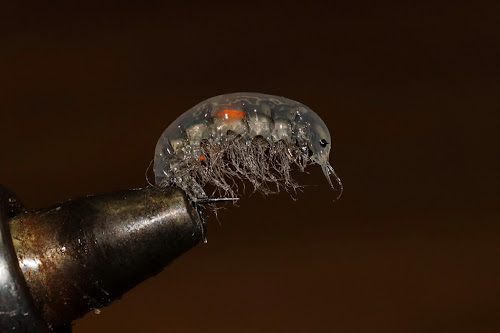As stated in the previous post this fly was designed by myself through experiences on the river, my main goal was to create something that was a soft touch with a transparent look as like the natural..
I have done these with or without the orange hot spot, this can act as a trigger for non feeding fish so see how you go.
The orange spot is actually in lots of natural shrimp, this is a parasite that is not harmful to the shrimp to the fish but one thing we know is it stands out very well to a fish.
It starts to cure in 5 mins with a skin on the surface so this gives you time to blend the silicone in with the dubbing as you will see further down the post..
The picture above shows the material used, there is not much and all the work is in applying the silicone..
Materials
Hook Fish On light gauge grub hook 14 16
Thread 'fish on tying silk' any colour
Dubbing (grey squirrel undercoat)
Orange spot (acrylic paint)
Silicone clear aquatic safe
Syringe (10 mm)
Lead wire (if used for weight)
Please note in my previous post I did the red dot in the middle of th shrimp by mixing the clear silicone with red dye and injecting into the clear to give a transparent spot but on this I have used orange paint
Wind down the thread to half way around the bend of the hook and take a good pinch of dubbing and scrunch up so I binds together.. You can use any dubbing you want but I have found squirrel grey under fur is soft and it really does give you the finish better than anything else.
Dub the polar bear to the eye of the hook keeping it quite scraggy, it can be trimmed up at the end..
Take the thread back to the middle of the hook..
Tie in the orange thread to create the parasite spot and trim off..
Here we have the fly ready to have the silicone applied..
You might need some practise but it's not as hard as it looks, try doing some on a flat surface creating a segmented body as you go along..
I empty the silicone tube into a syringe as this is s much easier to apply than using a huge gun for building. You can get these from a chemist for free if you tell them your a heroin addict!!
The method the apply silicone.....start at the eye of the hook and squeeze the syringe and work you way down the fly stopping as you go to create the ribbing effect... This is easier on bigger flys used for mullet etc..
As you can see I have applied the silicone here.... This is still wet so the next trick is to blend it in with the dubbing to make it look realistic and give the soft touch feel..
I use a needle for this or my finger to smooth it in... It sounds hard but it's very easy indeed
I was asked if its better to make them on a flat surface then tie them in once dry, I have done this but it does not look nowhere near as effective as this method above...
The orange dot can also be applied at this stage by dabbing a small amount of the acrylic paint
My results have been amazing on this fly and please let me know how you go on...
Don't forget if you need weight then add lead but I want it as light as possible like the natural, I tend to fish a heavy Jt flashback tungsten on the point and let that pull the shrimp down.. Then you have a light drifting soft touch shrimp that is transparent in the water!!!
I hope you enjoy this fly as I have done so early in the season.. Wait until the grayling are hard in the shrimp and you should fill your boots!!
As with all nymphing stay in touch with your flys at all times...






